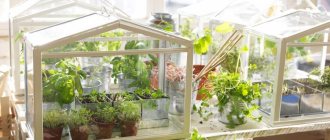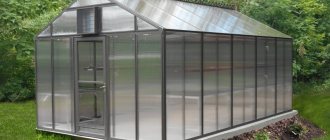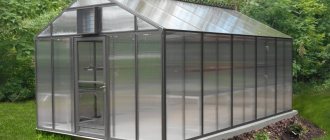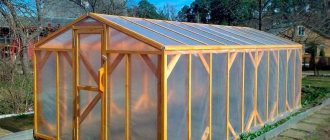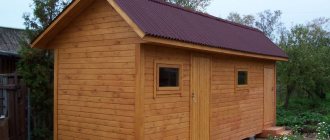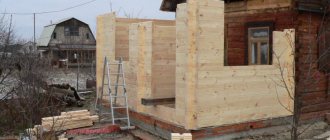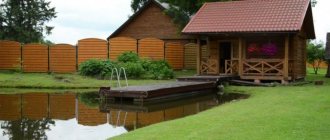Country and personal plots of various sizes need to be divided into functional zones where you can relax, arrange a food preparation area, or set up an orchard and vegetable beds. Greens, berries and vegetable crops are useful for adults and children leading a healthy lifestyle; their cultivation can be optimized by increasing productivity, which is possible when constructing a greenhouse on your own plot.
To build a greenhouse, you can use a variety of available materials, glass frames and high-density polyethylene film, but polycarbonate is especially popular among experienced gardeners.
After studying the provided photos of polycarbonate greenhouses and detailed descriptions of their own construction, you can choose the best option for growing environmentally friendly and natural food for the whole family.
Pros of using polycarbonate
Unlike glass greenhouses, polycarbonate has more advantages, such as:
Compared to glass, polycarbonate is much stronger. For example, snow in winter can cause glass to crack or even break, while polycarbonate is more resistant to bad weather.
It transmits less ultraviolet rays, which means that the plants you grow in a polycarbonate greenhouse will be burned less than in a classic glass one.
Excellent thermal insulation, compared, again, with glass, it retains heat better, since the polycarbonate material is two-layer.
Withstands temperature changes and maximum altitudes well. Glass may crack.
When heated, the material is flexible, making it quite easy to work with and drills well. Polycarbonate is produced in separate sheets of standard sizes, due to which you can cover the greenhouse with 3-4 sheets.
Compared to a glass greenhouse, a polycarbonate greenhouse diffuses the sun's rays, thereby preventing your plants from getting burned.
Well, the last, important plus is the price. A greenhouse made of polycarbonate will cost much less than one made of glass.
Coating
Greenhouses come with glass, polyethylene and polycarbonate cover:
- Glass is distinguished by its fragility, heavy weight and labor-intensive installation process.
- Polyethylene wears out quickly and collects water on the surface of the film.
- Polycarbonate is strong, easy to work with and durable.
Today, the best greenhouses are polycarbonate-covered greenhouses.
Cons of polycarbonate
But when choosing polycarbonate, do not forget about the disadvantages of this material:
Polycarbonate is not durable. Constant exposure to sunlight makes the greenhouse more fragile.
There are a lot of fakes, if you are unlucky and you purchased low-quality polycarbonate, then you may be in big trouble due to its insufficient strength. A standard good quality polycarbonate sheet will weigh 10kg, if yours weighs less it could be a fake.
There may be problems with additional heating of the greenhouse. Avid summer residents, in order to extend the harvest year, install additional heating in them.
- Lawn laying
A garage at the dacha is not a warehouse, but a modern and comfortable space!
Diesel generator for home: which one to choose?
Choice
Today there are a large number of ready-made greenhouses that will help crops avoid heavy rainfall, severe frost and scorching sun. First of all, you need to think about:
Consider a location option. The level of illumination, the presence of drafts and soil topography play a big role here.
- It is better to install the installation in a well-lit place, then artificial light will not be needed or will be used less often
- choose a calm and quiet place, perhaps near a low fence there will be less wind, thereby saving on heating the greenhouse
- the soil surface must be flat, then there is no need to install a foundation
Select the type (collapsible or stationary). The stationary option is suitable for permanent residence in the country.
Decide on the height of the plants to be grown. Tall crops will do well in a rectangular structure.
Foundation for a greenhouse
A polycarbonate greenhouse must be installed on a rigid base. So, what could be the foundation for a polycarbonate greenhouse:
The beam, it is worth noting that it is not advisable to lay it on the ground, it will not last long. Such a foundation can be fixed on piles or on brick foundations.
The brick is laid on a cement strip base. Such a foundation is durable, but again, only if it is laid out correctly.
Buying a polycarbonate greenhouse
You have finally decided on buying a greenhouse, then after reviewing a large number of photos of polycarbonate greenhouses, and choosing one, use some tips before purchasing:
Study the manufacturer carefully; even in products such as greenhouses, fakes are often found. It is better to buy not through an intermediary, but directly from the manufacturer.
If you buy a greenhouse through an online store, then check all the characteristics so that the structure does not arrive too fragile and you will not suffer large losses later. When receiving the greenhouse, check the packer's stamp with the date and shift number.
Please note that you are buying a completed structure, you do not have to finish it, if suddenly during assembly you were missing any holes or fasteners, keep in mind. You purchased a fake. If you have already drilled or fixed something in it, your chances of returning the item are minimal.
Consider the climate in which you live, how much the frame and the coating itself will be loaded. If your climate does not have a lot of snow, then you can buy a more economical greenhouse, in which the thickness of the carbonate will be less than standard.
Check the polycarbonate itself; if the ribs are pressed through, it means the product is of poor quality.
Please note that managers may take the economy version greenhouse as the basic design, which means the thickness of the polycarbonate will be thin and the frame will not be strong enough. Before purchasing, check the thickness of the coating and the material of the frame and, of course, the total amount.
Please note that when purchasing a stationary greenhouse with economical thickness polycarbonate, you will have to change the covering after 9 years.
Choosing a polycarbonate greenhouse is far from being as simple as it seemed at the very beginning. The same goes for building a greenhouse with your own hands, you need to carefully study the purchased material.
The best greenhouse for year-round use is one with a frame made of polypropylene pipes reinforced with timber. Construction with your own hands is not expensive, and the result will bring you great pleasure!
Frame
The durability of the entire structure depends on the frame. Manufacturers offer several types:
- Wood. Low cost, but capable of absorbing moisture, which contributes to rotting and frequent repairs
- Plastic. Durable, rot-resistant, light weight, easy to install, but expensive
- Aluminum. Identical to plastic
- Steel. Strong, durable, withstands heavy loads, low cost, but susceptible to corrosion.
